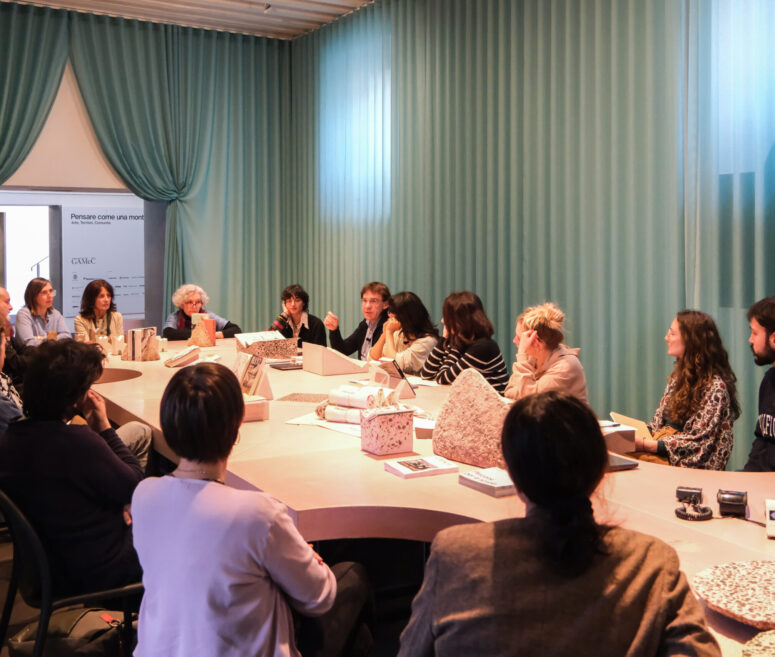The third meeting of the series featured curator Greta Martina and anthropologist Adriano Favole.
The discussion, of which we publish an extract, focused on the themes explored by the project Fossi io teco; e perderci nel verde, winner of the 12th edition of the Premio Lorenzo Bonaldi.
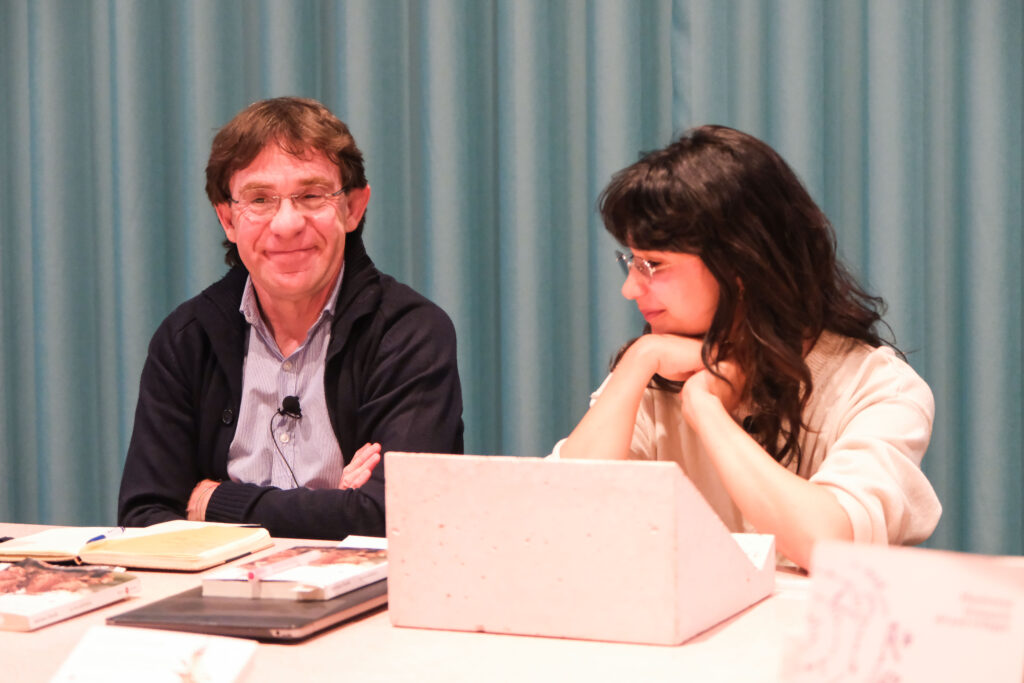
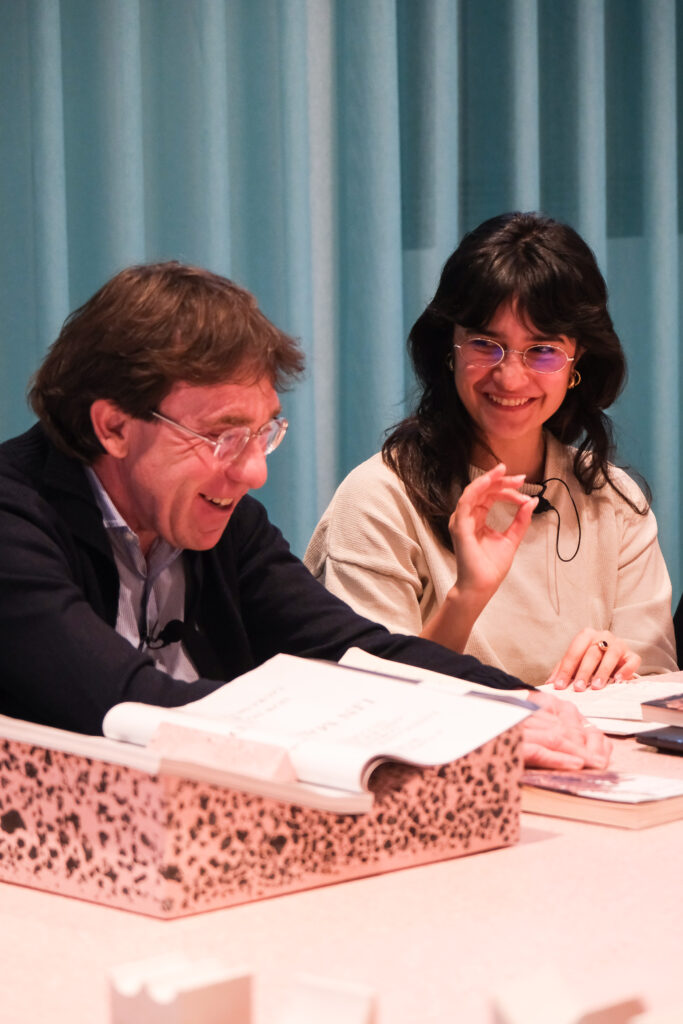
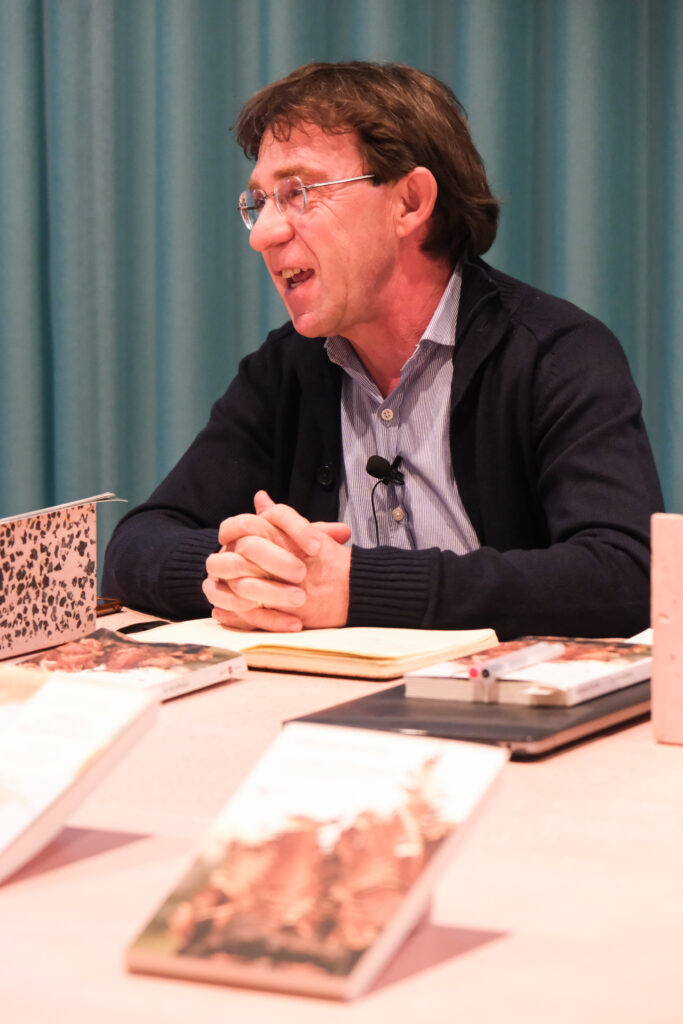
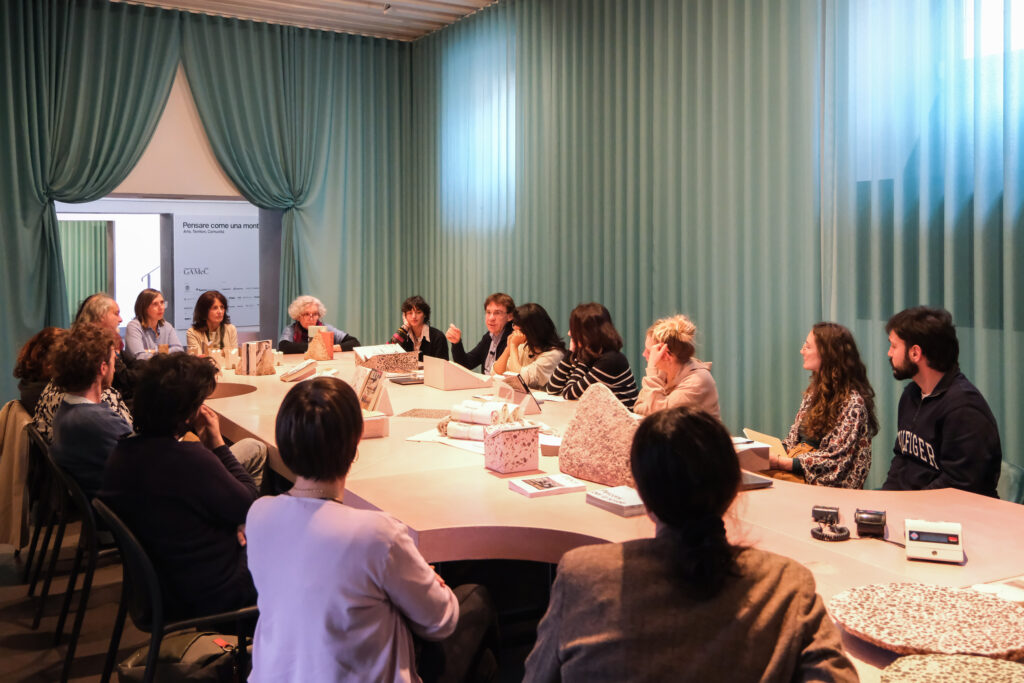
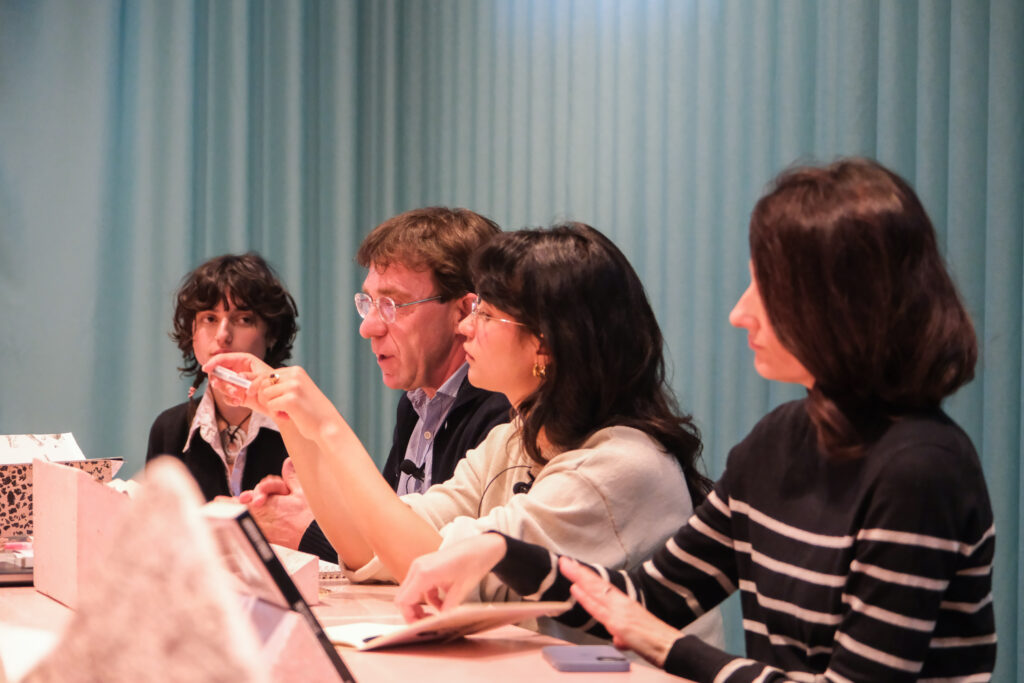
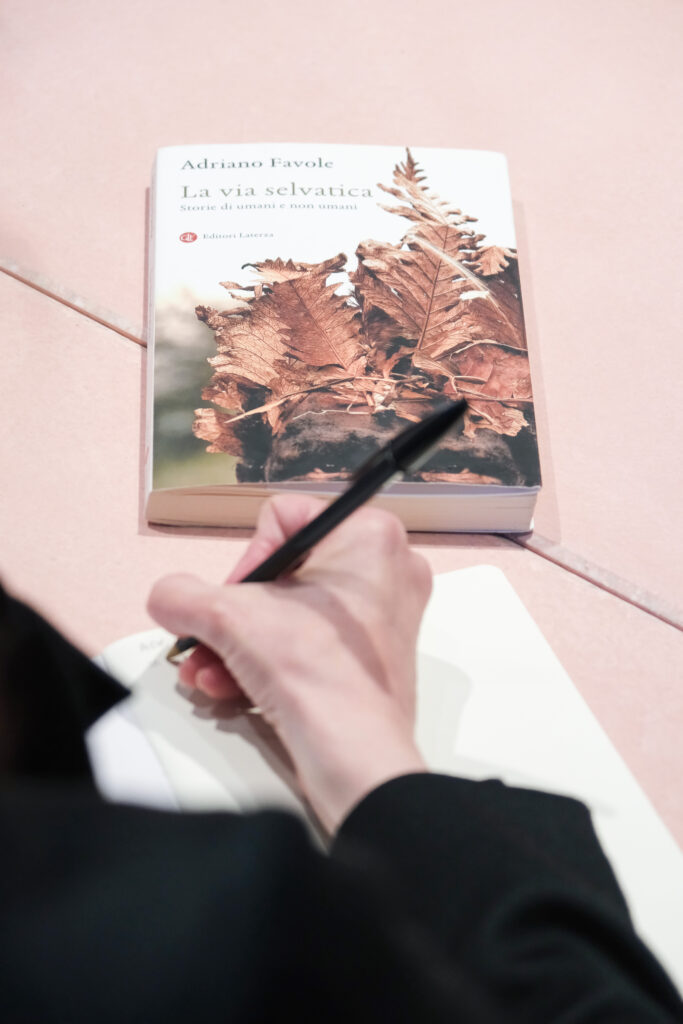
SARA FUMAGALLI
Adriano Favole is a Professor of Cultural Anthropology at the University of Turin. He is an anthropologist who has carried out many years of fieldwork in Futuna, New Caledonia, and other overseas European territories. Since the 1990s, he has published numerous important texts—we’ll just mention the most recent ones here: Vie di fuga (Utet, 2018), which we were discussing earlier, Il mondo che avrete (Utet, 2020), co-authored with Marco Aime and Francesco Remotti, and of course La via selvatica (Laterza, 2024), the book we are presenting here tonight in dialogue with Greta Martina.
Greta Martina is the winner of the twelfth edition of the Lorenzo Bonaldi Prize for Art, an award dedicated to emerging curators under thirty who are just entering the profession. This year, we invited the participating curators to develop a two-part exhibition project: one to be held specifically in Serina, inside a former monastery and in direct dialogue with the local community—whom we sought to involve actively, including during the opening—and the other, as per tradition, in Spazio Zero: our project room at the museum.
Tonight, Greta Martina will talk to us about the exhibition Fossi io teco e perderci nel verde (“If only I were with you, losing ourselves in the green”), which she curated, starting out from a text that partly inspired its concept: La via selvatica (“The Wild Way”) by Adriano Favole. I shall now give the floor to our guests, and I thank them both for being here with us this evening.
GRETA MARTINA
“Fossi io teco e perderci nel verde” is a line by Giovanni Pascoli from the poem “Romagna.” The line inherently expresses a desire for relationship: there is an “I,” a “you,” and a space that embraces them both—the green: a third presence which, though not human, is equal, essential. A threefold relationship thus takes shape, in which all the entities involved hold equal value and meet in this shared, all-encompassing dimension.
The invitation to “lose ourselves in the green” should not be understood as an escape or retreat from reality, but rather as a call to attune ourselves to the rhythms and needs of this green, understood as a living, pulsing space. In this sense, it resonates deeply with what Adriano Favole defines as the “uncultivated,” and thus the “wild.”
To me, the idea of the “uncultivated” is inextricably linked to the green: something that sprouts, envelops, and grows lushly—the green of meadows, of forests, of the vegetation that surrounds us. And it is from here that I would like to begin as we explore the sense of this “uncultivated” together.
ADRIANO FAVOLE
It is truly a great privilege to see how certain reflections, ideas, and even stories present in this book come to life in the exhibition curated by Greta Martina, in the artists’ works, and, more broadly, in what we’ll be discussing together this evening.
Indeed, the book revolves around one word—the “uncultivated.” Some of my books begin this way: from a concept that I try to explore in various directions while keeping the focus on what lies at the center of my work as an anthropologist and on what has been communicated to me around that word. In this case, the term “uncultivated” becomes “wild” in the title, although they are not exactly synonyms but rather overlapping terms. The idea of the uncultivated, as you rightly pointed out, is summed up in the word teco (“with you”)—a beautiful old term that implies a relationship. It also reminds me of another term, more common in my dialect—that of Cuneo or Piedmont—which is nouiauti (noialtri in Italian or “us lot”), an expression we use instead of “we,” and which already contains a relationship, an openness to the other. A word that would deserve a history of its own, being so rich in meaning.
“The Wild Way” does not suggest—as one might assume—the abandonment of everything human or symbolic in favor of retreating into untouched nature. On the contrary, it sets out from the idea that there is no culture without nature, nor is nature untouched by culture. What we are is, essentially, in a relationship.
The concept of the uncultivated came to me from two very different experiences that, at a certain point, intertwined. The first is more personal: I come from a farming background. Until the age of five, I lived in a large farmhouse where my grandfather was a sharecropper, and from there, I come from a long line of farmers. Even after moving to a more modern house, I continued to live close to the fields, to the cows, even though it was no longer the same farmhouse—the Casa Bianca, which today lies largely in ruins. In that initial part of my life, my education meant learning relationships: between the seasons, the cycles of sowing and harvest, which all resonated with bonds.
I remember, for instance, when my grandfather taught me to fish: it wasn’t just a technical gesture, but the learning of a web of relationships. Knowing when fish are hungry—trout at the end of February, barbel and chub from May to June, carp in August—meant listening to the rhythms of nature. Fish don’t eat everything; on the contrary, they are picky: They want different larvae depending on the season, the current, and the part of the river. That’s how I learned that knowledge is relational and that even the uncultivated—that which is not cultivated—could be a source of wonder. A wonder perhaps excessive for a world that was already vanishing: the uncultivated was the realm of hares, pheasants, bees, of a biodiversity that emerged through the rhythms of the year.
Then, for years, I seemed to forget all this, immersed in a profoundly human and symbolic world. I studied philosophy, then cultural anthropology, and I focused on exploring kinship systems, rituals, and cultural policies. All deeply human things.
More recently though, I’ve gone back to living in a house that overlooks a forest. It’s the forest where the book begins—not a fairytale forest, but one that sprang up along the path of an old railway line—the Torino–Savona. It’s a returning forest, where foxes and badgers now pass through, and dozens of bird species live. This proximity brought me back to the wonder of relationships and the power of the uncultivated.
The other experience, which is more research-based, comes from Oceania. The societies I encountered there don’t use the notion of “nature” as something separate from the human. In many local languages, there isn’t a word for “that which is not human or artificial.” Rather, there are words that refer to relationships between humans and other living beings or to the regenerative capacity of what we call nature.
As far back as fifty years ago, a number of authors observed that in New Caledonia—the first archipelago you encounter traveling from Australia into the Pacific—the concept of “uncultivated” is very pertinent. There, the forest is not simply non-human; it is rather what is not yet human or no longer human. It is the place of spirits, of the souls of the dead. And it is also the place where humans return—with their bodies, with their remains. The uncultivated is a border, a threshold, a porous boundary between the human and the non-human.
So, I began to reflect on how we humans carve out zones of culture—the cultivated—within an uncultivated that surrounds us and inevitably reclaims its place. La Via Selvatica is thus an exploration of this relationship, not a return to some untouched green, but a form of listening to that which constantly escapes us and crosses through us.
GRETA MARTINA
Later in your book, a reflection also emerges on the idea of separation—a separation that, at least in our liberal conception (though it has far older roots), opposes nature, culture, or civilization. A dichotomous vision that, however, is not the only possible path.
This separation is already present in the very language of the exhibition: the act of exhibiting implies a display, a decontextualization of the object, which is thus transformed into an autonomous entity, a symbol. This transformation can be problematic and certainly deserves further examination.
Nonetheless, inside the exhibition, we may pick out meaningful examples of a possible middle ground between culture and nature—an attempt to shorten the distance that is also reflected in curatorial language and the very organization of the exhibition project. On the one hand, there is the exhibition inside the museum space, which invites the viewer to enter the institution; on the other, there is an outward movement, a centrifugal tension that the exhibition shares with the broader program Thinking Like a Mountain. This program, in fact, is not articulated solely within the institutional space of the museum, but seeks to inhabit and activate other places.
The first example of this movement was the exhibition opening, which did not take place inside the museum but in a monastery in Serina: an initial shift toward the outside. This gesture then re-entered the exhibition space through the performance Rudimenti by Enrico Malatesta, held in March, which animated a room conceived to host not only the work itself—the object—but also human presence and its dynamics.
However, I would like to focus on another episode, one which I find particularly emblematic of this search for a middle way between nature and culture: Superpaesaggio, a performance—or rather a performative event—held on March 16 at the Rocca in Bergamo. A place that may be interpreted as a “third landscape,” according to the definition given by Gilles Clément, also referenced in the book: a space that had an original function and today takes on another, completely different one.
On that occasion, we all went to the Rocca and, following the instructions given by the artists—Attila Faravelli, Nicola Ratti, and Enrico Malatesta—we embarked on a shared sound walk. The artists had brought various instruments, like iron marbles, magnets, and Walkmans, but the performance was also constructed through interaction with the elements from the site itself: branches found on the ground, metal grates, and natural surfaces. The experience prioritized listening oversight—a sense more inclined to sharing and relation, whereas vision tends to hierarchize and isolate.
This centrality of listening does not end with the performance but returns within the exhibition, where sound is a key feature of many of the works. It is also an element that resonates with the poetics of Giovanni Pascoli. Pascoli indeed defined himself as a “musical poet,” and his fanciullino—the “little boy” who served as the emblem of his poetic vision—is precisely a musical poet: one able to hear and perceive those sounds that, in theory, all of us might still be able to hear. The difficulty in catching them does not lie so much in our age or their fragility but rather in the surrounding noise.
Thus, the idea is to re-attune our ears—and more broadly our attitudes—toward the uncultivated, toward what is not domesticated, toward an un-reduced otherness. In short, to search for a path that can lead to a mingling, or at least to a living contact, between nature and culture.
ADRIANO FAVOLE
Yes, rather than retracing the entire history of this opposition—which is long and which lies at the heart of a vast debate, also in contemporary environmental anthropology—I think it’s worth pausing on a few key points. When exactly did the idea come about that nature is something separate from human beings? There are many possible origins. Some trace this distinction back to the invention of agriculture when humans began to “produce.” But this is debatable because agriculture itself has long been—and still is, in some cases—the result of a dialogue with the non-human. Who can truly cultivate without relying on a relationship? And since when in history have humans seen themselves as the sole protagonists of agricultural interventions?
Others claim the nature/culture distinction is very ancient: one need only think of the moment in Genesis where it says “you shall have dominion over the animals, and use them for your purposes.” In this vision, there is already the seed of what would become the Anthropocene—a world in which human beings dominate almost absolutely. But for thousands of years, even though humans carved out cities, fields, and infrastructure, cohabitation with the wild remained largely virtuous, or at least it didn’t do irreversible harm to the environment.
To find substantial signs of what we are experiencing today, we need to go at least as far back as the Industrial Revolution, if not to the post-WWII period: that’s when all the graphs—CO₂ in the atmosphere, ocean acidification, waste production, the number of international flights—began to rise exponentially, laying the foundations for the climate change we’re now experiencing.
All this is to say that the nature/culture opposition is part of a complex and layered history which deserves further discussion. But today, I’d like to pick up on the theme you mentioned, entering more directly into dialogue with what you said about how you envisioned the exhibition and performances.
There’s a challenge for art today—and I certainly don’t want to take anyone’s job—and it’s precisely that of it no longer thinking of itself as separate from the world of the non-human. Art, by definition, seems to be an exclusively human, symbolic thing. But for that very reason, as you suggested, it’s interesting to consider other societies—let’s call them that, for simplicity’s sake—where art has always addressed this issue.
I’m thinking, for example, of the Kanak in New Caledonia, the native people of that territory. When the first French and European collectors arrived there at the end of the nineteenth century, they found large anthropomorphic sculptures—those we now see at the Musée de l’Homme in Paris, the British Museum in London, or in other European ethnological museums—objects that served as the doorposts of huts, interior decorations, or the famous flèches fêtières (roof-top arrows), also with anthropomorphic elements and decorations like shells, evoking sound, calling, contact.
These objects are what the Kanak used to leave in the forest. They came from the forest and returned to it. And that’s where they were meant to stay. They were part of the cycle. The oldest objects we have in museums today are badly damaged because they had been left outside for decades, perhaps even centuries. But when the Kanak realized that Europeans were willing to pay for such objects, they began to carve new ones specifically for the market. And so within twenty years, you find objects that are “well made,” no longer damaged by rain and time.
This dynamic—of human art that emerges from the wild and returns to it—is found in many cultures. I think, for example, of certain societies in the Highlands of Papua New Guinea, discussed by the French anthropologist André Itéanu. In those contexts, huts were built with trees chosen specifically because they would sprout again. So when a hut was abandoned, it turned into a little wood. They used “living” wood in dialogue with what would continue to grow.
It’s a way of saying we are part of a circularity, a continuous relationship with what surrounds us.
And here, the idea of the “third landscape,” which you mentioned, returns. This notion can be seen as a contemporary translation of the “wild.” The term comes from Gilles Clément—perhaps you know him, maybe you’ve seen his installations in Paris or elsewhere in Europe. His idea, which goes back a long way, is that our relationship with the environment isn’t reappraised only by immersing ourselves in pristine, hyper-protected forests. Sure, it’s important for these to exist and be protected. But the point is: the relationship with the living world is also built with the park in front of your house, in the little urban garden, in your neighbor’s messy hedgerow. Why do we cut the grass in April when it’s full of blooming flowers? Let it grow at least until May.
This is the third landscape: working with what we have around us, marveling at the lives that surround us. It’s a simple gesture but a powerfully symbolic one.
A brief personal anecdote: a few years ago, I went up into a part of New Caledonia, looking for a place described by Georges Haudricourt, an ethnobotanist who was the first to introduce the notion of the “wild” in reference to Oceanic societies. The Kanak still use the word “tribe” to describe their traditional settlements. While I was searching for these places with a guide, at one point, he showed me a little booklet where he noted the visits of foreigners, and he revealed that twenty-five years earlier, someone considered important in France had passed through there—Gilles Clément!
Clément had gone right there, to those places where such thinking on the uncultivated took shape. Haudricourt, by the way, was the teacher of Philippe Descola—perhaps the most important contemporary anthropologist working on nature and culture. Sometimes, it’s in seemingly distant, marginal, peripheral contexts that ideas are formed that turn out to be important for all of humanity.
All these threads—between the Kanak, Haudricourt, Clément, and Descola—bring us back to the profound meaning of the third landscape: an invitation to enter into dialogue with the generative force of nature that surrounds us, even within the city.
And the cover photo of my book, which may seem so “exotic,” with the face covered in vegetation, is actually a very common image in Oceania. The dancers adorn themselves with what they have around them: flower necklaces, leaves, fibers. They construct a symbolic image of themselves—not to imitate nature but to declare a relationship with it.
GRETA MARTINA
One of the works in the exhibition that, in my view, perfectly encapsulates the idea of referencing the surrounding territory and its transposition into the exhibition space is Corridori Lenti (“Slow Runners”) by Umberto Pellini. It consists of a series of fifteen spheres made of mud, soil, and water—materials collected during the artist’s stay here in Bergamo. The practice is thus rooted in the act of exploration and direct interaction with the land, in an almost ritual dimension.
For months, Pellini mixed these elements, repeating a gesture he describes as “almost like a caress,” until he obtained these perfectly smooth, round, almost artificial spheres. Yet the contrast is striking: despite its geometric perfection, the sphere is perhaps the form that most evokes the idea of nature—of something that exists independently of human intervention. In this sense, the sphere becomes a site of tension between what is organic and what is manipulated, between what is given and what is constructed.
The time required to create each one—about a month per sphere—introduces another fundamental element: a slow rhythm antithetical to the frenzy that characterizes our urban daily lives. It is a pace that does not respond to the logic of productivity but instead adapts to the needs of the material itself—its behavior, its response times. Thus, the work becomes an act of listening and trust, as the artist has no guarantee of the final result: each sphere might fail and might not be smooth and shiny. Yet this risk is an integral part of the work.
There is also a gesture—almost a contradictory one—in the attempt to transform a raw material like earth into something perfectly complete, readable, and controllable. This same tension appears in another work by Pellini: Io, Tu, Una Casa, Una Città (“I, You, A House, A City”), in which he creates small modular constructions in concrete reminiscent of children’s toys. Again, the artist tries to reduce and simplify urban complexity to make it manipulable and understandable. It’s an attempt to scale down what usually overwhelms us, a way to play with it, but also to size it up.
All of this seems to respond to a deep need: for an art that does not merely represent but directly engages with the material and symbolic conditions of our time. An art that doesn’t offer solutions but suggests pathways—as you yourself say, a “creative coexistence.”
In this sense, I would ask you: how can we, today, from within artistic institutions, address what you describe in your book as a semiolimia—an excess, an overabundance of symbols?
ADRIANO FAVOLE
There are some very interesting issues connected to what you were saying earlier regarding Umberto Pellini’s work: one is the idea of slowing down time, which is one of our great contemporary issues. We live in an increasingly accelerated world, a time that slips away from us and to which we try to react. Thomas Erikson, a Norwegian anthropologist who passed away last year, wrote a very interesting book titled Out of Control: An Anthropology of Accelerated Change. An accelerated world, a heated world, where he explores this continuous race, the panting that accompanies each of our steps and every one of our deeds. The issue Erikson raises is precisely the need to stop, slow down, and think before acting, and this is a proposal that art could embrace as a keyword: “slowing down.”
The other theme I have always approached with great interest, and which is very relevant today, is “improvisation.” This is a concept that has always been central in art but is also heavily emphasized by anthropologists, especially Tim Ingold, one of the great scholars of environmental anthropology. Ingold wrote a book that specifically addresses the theme of improvisation. To improvise, in its deepest sense, does not mean acting thoughtlessly or being out of place, but it implies building works of art and also building lives in which not everything is already defined, programmed, and rationalized.
I often share stories from my travels to the worlds I frequent, places that are by no means out of the world or primitive but where there is a strong component of daily life that resists the excessive planning that dominates our modern societies. I’m talking about the people we call “indigenous,” who already lived in places that were then colonized, and one of their calls for decolonization is precisely this: to free them of the excessive rationality and planning of lives, which is part of the great burden of colonization. Often, in our societies, everything is defined right from the start. School is a pre-established path, life is like a script you must follow, and “success” depends on how fast you follow it. However, the idea these people propose is that, instead, there are alternative possibilities and spaces of freedom, and art becomes the place where such alternatives can be explored. There is not just one path to follow. The artist, in this view, claims the freedom of improvisation, where it is not clear where the path will start nor what the final result will be. It is the freedom of not having absolute control, of living without a preordained plan, just like in Pellini’s spheres.
You asked me about the concept of semiolimia. “Semiolimia” is a term I coined to describe the impression of living in a world where reality is dominated by symbols, words, and representations. In our philosophy courses, Gianni Vattimo spoke to us about the age of the representation of the world, an idea developed by Martin Heidegger. My travel experiences have shown me that there are social worlds where the symbolic “thins out,” where there are no street signs, advertisements, traffic lights, or visual signals that overwhelm our daily lives. The reality of these places is less dense with those symbols that we perceive as the only access to reality itself.
In some islands, like those to the north of New Caledonia, there are no signs of the symbolization that invades our cities. The houses are almost hidden by vegetation; there are no street signs, no advertisements, and no flashing lights. This doesn’t mean there are no symbols in these places, but it’s as if these symbols were less obsessive and less pervasive. And this is an important point because, as semiologists would say, reality does not exist without symbols. It’s true that the only access to reality passes through symbols, but sometimes it feels as though these symbols oppress us, like in the case of plastic whales that are displayed in cities, as if representation were more important than the reality it is supposed to represent.
Semiolimia is precisely this obsession with symbols that distances us from direct relations with non-humans. Can art reintegrate this relationship? Bring us back into dialogue and peace with the spontaneous and tangible spaces of the wild? It seems to me that Fossi io teco offers very interesting proposals in this regard.
GRETA MARTINA
For me, this is a topic to discuss not because I have a definitive answer but because, reflecting on the exhibition or the exhibition project itself, the main idea or the focus I believe was emphasized both by myself and the artists relates to the process that ultimately leads to the result. Symbolism and process both play a crucial role. In this specific case, the process is not viewed as something that only leads to the final product, but rather the process itself is a protagonist. This unfolding has a particular characteristic, a distinguishing element: it often starts from the place and returns to the same place where it all began. It’s a process that is nourished with fragile and humble materials that don’t pretend to be grandiose. Some of the works, for example, are made from paper, cardboard, earth, or even sound that has simply been collected and recorded. So there is a focus on the little things, on that wonder that comes from being able to marvel at what surrounds us. This wonder doesn’t have to be a symbol of gigantic proportions, but it’s found in rediscovering the importance of even the smallest element that we can notice.
Then, certainly, the rhythm of this process is another key point. As I mentioned earlier, the process is slow; like in Corridori Lenti, the word “slow” is even in the title, which is emblematic of this idea. It’s a repetitive process, so it’s not something that happens quickly but rather a process that unfolds with slowness, meditation, and repetition. There’s the same gesture that gets repeated, almost like a mantra the artist must repeat over and over again, and this requires a certain patience on the part of the artist first and foremost. It’s precisely this slowness that characterizes the process, a meditative one that steps away from the idea of speed or immediacy and eventually leads to the creation of the object itself. However, this object is not necessarily something we perceive visually: sound is a protagonist in this project, and not just in the traditional sense but that when you enter the exhibition, you realize the space is not particularly full of objects. The visibility of the objects is intentionally limited, but the idea of there being movement is strongly present—not so much of the objects on display but especially that of the spectator. The real action, the real movement, is that of the spectator entering the exhibition space. It’s as if the spectator were to “inhabit” the exhibition space, interacting with it. The works have been conceived in a way that allows them to be hung or placed on plinths of various sizes. I was struck by how, when entering the exhibition with a group of visitors, this idea of movement and dynamics was also reflected in the curatorial language, which sought to embrace the idea of walking, searching, and discovering. There are small houses in the exhibition, so small that they must be looked for. So movement is tied not only to the body walking but also to the gaze, moving in search and perception.
I think this might be a path to explore: an exhibition that is not only centered around the exhibited object, but that acknowledges the human presence, not just as a passive consumer, but as an actor who interacts with the space. The concept of movement, in this case, takes on a dual meaning: it is physical, but also visual, cognitive. An experience that is not predefined, but built through interaction and active participation.
The format of this exhibition and its events is not one that aims to build social cohesion in the traditional sense, where everyone is brought together in one large meeting. There’s a certain openness, a free experience that allows each individual to live the experience autonomously, without a specific chronological sequence. You don’t need to be there exactly at 6 pm, for example, on a particular afternoon. But this format, while not aiming at immediate cohesion, opens up spaces for scheduled encounters. There are events that repeat every month, creating appointments that bring together a community of diverse people who meet to experience art. In this format, you don’t participate in a pre-made performance, but you become a part of it, part of the process. You enter into a relationship with the artist, with the work, and with the territory hosting us.
A key example of this process will be the event in May, involving the group O Thiasos Teatro-Natura, a theater company that will present a touring show in a green setting, one which becomes the stage together with the artists. The uniqueness of this show is that it won’t take place in a theater but in a natural space that becomes an integral part of the event. The audience’s participation will no longer be passive, like that of an observer, but active: the audience will walk, move, and interact with the spaces and the artists. It will be a true creation shared with the spectator, who will no longer be just a spectator but an active participant in the creative process.
This model of events, which integrates performance, concerts, and theater shows, aims to achieve greater inclusion, avoiding the traditional structure where a few speak to many. In a society that aspires to be democratic and polyphonic, the voice should no longer be exclusive to a few but extended to everyone. This is the direction we should be moving toward: a collective experience that is built together, a shared journey where art is not just a spectacle but a continuous interaction and discovery. That’s why I believe participation itself, the lived experience, becomes the true value of these events.
However, this is just my opinion. Of course, everyone has their own vision of what art represents, and this is an issue that will always remain open and in constant evolution.
SARA FUMAGALLI
Something that struck me greatly is the synergy created between the concept of the wild, which Adriano Favole just mentioned, and the artists’ proposal. At first, in my romantic vision of nature, I was surprised that they didn’t look for places “outside”: in nature, in the forests, in the hills, far from the city. On the contrary, the artists chose places where nature and culture—understood as the expression of human creation in historical, architectural, and urban terms—are co-present. This is indeed the interesting aspect: active listening to nature does not exclude either of the two terms, neither nature nor culture.
In this choice, there is a key element: the integration of these two worlds, where the performance becomes an experience of awareness and reflection, without explicitly verbalizing it but living it. When we are in an urban context, the concept of rediscovering nature within the city is not just an experience of passive contemplation but an experience of activation, a process of attention that invites the community to notice those elements of nature that, despite being so close, are often ignored.
Perhaps the choices made by the artists with regard to the places in which to stage their performances might be seen as a possible answer to the question you posed earlier: how can art be brought to a level that is not merely symbolic?
One last question: contemporary sciences, such as neurosciences, draw attention to how from the earliest moments of life the relationship with others is decisive in the development of the human being in both biological and cultural terms. How do these studies affect the conception of the human being?
ADRIANO FAVOLE
The notion of brain plasticity is precisely this: the idea that the relationship and interaction with others and with the environment is responsible for the formation of our microcircuits in the brain. In the end, the second half of the twentieth century was a real revolution for the neurosciences because the idea shifted from a brain that grew essentially programmed by strict genetics to a brain in continuous transformation. A few years ago, when I was working on the intersection between anthropology and neuroscience with my colleague Stefano Allovio, I noticed how many neuroscientists often use the metaphor of sculpture or pruning trees. The brain, in fact, is like a tree to be pruned: you need to give it shape. So there is this dimension, this ecology of relationships, the ecology of the mind. I think of a book called Towards an Ecology of the Mind by Gregory Bateson, a famous anthropologist. The ecology of the mind is an ecology of relationships.
By the way, I’ve often discussed the themes of the wild with psychoanalysts, who look upon the idea of the wild as a reference to the unconscious. There is this partially cultivated dimension that eludes rationality, but it’s never completely “wild,” like the field returning to its natural state, but not entirely because the environment we live in is always actually a synthesis of the cultivated and the uncultivated. An interesting example is the Amazon. For years, we thought of the Amazon as the last great untouched forest in the world, but that’s not the case at all. The Amazon is a forest co-constructed by the hundreds of thousands of people who lived in that environment before the arrival of the West. In actual fact, the Amazon rainforest is a completely reconstructed environment: the plants have been moved, selected, and placed back into a dialogue with human spaces. Today, thanks to aerial surveys, more than fifty small towns and a road network that connected much of the territory have been discovered.
So, this idea that nature exists without dialogue, without relationship, is a romantic one. Someone here has defined it in such terms, but it is so deeply rooted in common sense that we struggle to break free from it. For us, the idea of nature is very much tied to a concept of separation: us and nature, as if they were two distinct entities.
Q&A
I have one last thought: when you started speaking, as an architect, I immediately thought of Gilles Clément, who is a sort of legend for us, especially for my generation, because he truly revolutionized thinking about human intervention in landscapes, about the art of gardens. When I studied architecture, there was a discipline called the art of gardens, but now it no longer exists, which is paradoxical. Today, the paradox lies in the fact that, for example, along our main street (Via XX Settembre, Bergamo), the project for the recently renovated “piecentiniano” center includes those flowerbeds that I believe are still a topic of debate among pensioners sitting on the benches, asking “what kind of flowerbeds are these?” In actual fact, those flowerbeds were designed according to Clément’s concept of the third landscape, which calls for spontaneity.
Spontaneity is a concept that could open up great debates: What kind of spontaneity? The essence that builds the flowerbed should no longer be one that seeks chromatic harmony or an overall design, as has been the case throughout the history of garden art. There has always been the pursuit, on one hand, to represent a form of nature that is no longer natural but one imagined and represented by humans, and on the other hand, there is the mantra of ecology, which in turn becomes a paradox. Thus, we find ourselves longing for an apparent spontaneity that perhaps reverts to the picturesque style of English gardens, with willows, hillocks, and winding paths, instead of the geometry of Renaissance and classical rationality. In fact, we continue to chase an idea that perhaps eludes us.
And in all this, perhaps architecture always carries with it that idea of the project as a principle of transformation. It holds the essence and the will to affirm a condition of thought and action that ultimately produces something quite unlike the object upon which we exert our overall way of living.
Q&A
For some time now, in Milan, they have started reducing the frequency of mowing public green spaces and even parks. In the past, the mowing calendar was very strict, but now they are extending the times, which has led to the return of many wildflowers and insect species, allowing all the organisms that inhabit them—both plants and animals—to complete their life cycles.
ADRIANO FAVOLE
This opposition, which we now simplify as nature-culture, is deeply rooted in our thinking and is part of common sense. As anthropologists, when we talk about common sense, we refer to those kinds of knowledge that seem obvious and are taken for granted, as if “things are just like this,” and there’s nothing to discuss. But, in actual fact, this common sense is a way of seeing things that can be questioned when you step back and try to look at things from another point of view—whether it’s historical, anthropological, or artistic.
This discourse is reflected greatly in language and daily practices. If you begin to think a meadow is beautiful even if it has a variety of different grasses, instead of seeing it only as a monochromatic field of selected grass, you realize how deeply rooted this perspective is. It’s not that people aren’t sensitive to the environment; it’s the culture we grew up in that taught us to see things in a certain way. It’s not that my neighbor lacks sensitivity, but if they see a different kind of grass in the meadow, it drives them mad. If they see a brown leaf amidst the green, they instinctively need to grab that infernal machine that blows it away, even though the wind will just bring it back again. These are lost battles, but we feel human when we do these gestures because that’s how we’ve been taught to act: fight, intervene, cut the tree. However, there is a growing sensitivity to these issues. When the municipality decides to cut down a tree today because it’s rotten or for safety reasons, it may be immediately sued, so this is a sign of change: greater attention to dialogue with non-human elements.
I remembered a photo I took a while ago. It’s interesting how sometimes a theme sticks with you, and then you see it everywhere you go. Many years ago, I wrote a book about death, and from then on, I kept noticing cemeteries everywhere. Now, though, I go looking for wild plants. I remember a place in France, in an abandoned area, where, in a garage, there was a piece of writing that I later discovered was a quote from a French poet. The phrase went something like this: “The weed is just a plant that has learned all the survival skills except how to stay in line.” It was funny, a reflection that reassessed the weed, and it made me realize we are not the only ones recognizing the value of these plants. In short, the conversation has taken us far from architecture, but it’s interesting how ideas evolve in our relationship with nature.



